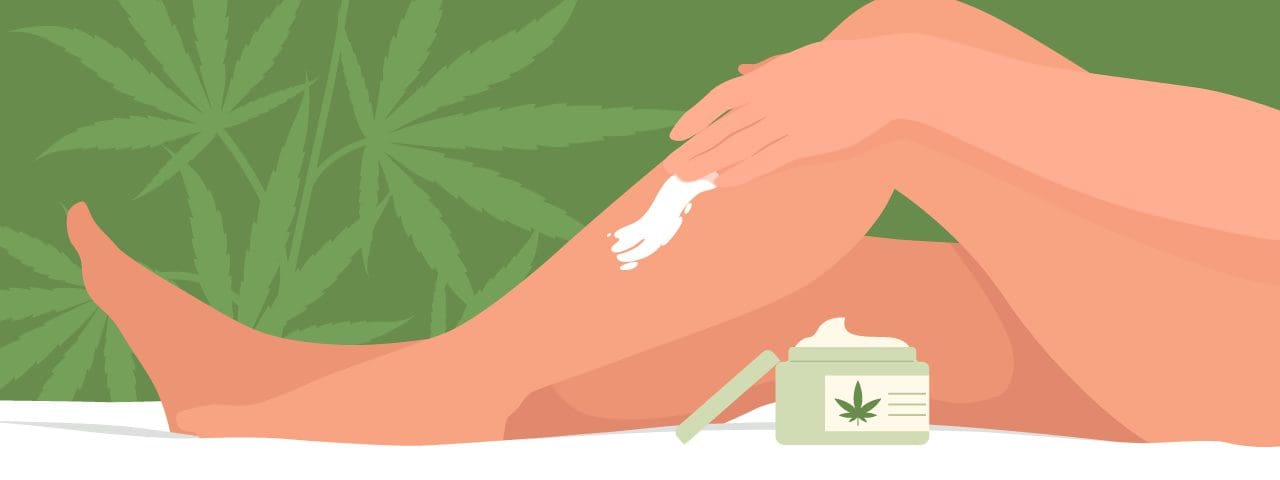Can cannabis help with back pain?
4 min read



Some research suggests that certain compounds in cannabis, including tetrahydrocannabinol (THC) and cannabidiol (CBD), can help relieve back pain. THC and CBD interact with receptors in your body that help regulate pain and inflammation caused by back injuries, muscle strains, or spinal issues.
While larger studies are needed, research on cannabis for back pain has promising results.
It’s important to speak with a doctor before using cannabis for back pain, especially if you take other medications.
Get your medical marijuana card
Connect with a licensed physician online in minutes.
Larger purchase limits Access to higher potency strains Save up to 40% on product taxes Enhanced legal protection
Does weed help with back pain?
Cannabis likely helps some people manage back pain because cannabinoids in cannabis, including THC and CBD, interact with your body’s endocannabinoid system, which helps regulate pain and inflammation.
Research on cannabis for back pain specifically is limited. That said, several studies support its use, including a pair of phase 3 clinical trials published in 2025:
- A placebo-controlled study of 820 people found that full-spectrum cannabis extract helped reduce pain, improve sleep, and support physical function in people who have chronic low back pain.
- A randomized trial of 384 adults with chronic low back pain reported that a cannabis extract medication demonstrated superior pain relief, improved sleep quality, and fewer gastrointestinal side effects compared to a commonly prescribed opioid.
Other research on cannabis for back pain has found:
- Cannabis caused few side effects: According to one review of studies, cannabis may help ease back pain without causing serious side effects. Another review had similar findings.
- Edibles were effective for back pain: Findings from a study of 249 participants note that cannabis edibles may help ease low back pain. THC-based edibles were found to be more effective, but CBD-based options may be just as effective with more frequent dosing.
- Patients reduced opioid intake: Opioids are commonly prescribed for back pain, but they can be highly addictive. In a study of 180 people with back pain, most were able to reduce or stop using opioids after starting cannabis treatment.
CBD for back pain
CBD is a nonintoxicating compound in cannabis. Some people use it for help with insomnia, pain, and inflammation.
Some research suggests that CBD can be used as an alternative to opioids to help ease chronic pain. However, studies on CBD specifically for back pain are limited.
One small study of 48 participants found that CBD gel caps significantly reduced low back pain in people with lumbar spinal stenosis, a condition where the space inside your lower spine narrows and puts pressure on nearby nerves.
CBD might also help improve symptoms of insomnia. This can be especially helpful for people whose back pain interferes with sleep.
Does weed help with sciatica?
Sciatica is a condition that causes pain, tingling, numbness, or weakness along the sciatic nerve, which runs from the lower back down each leg.
In a small study of 46 participants, smoking cannabis helped improve sciatica symptoms, including low back pain.
Other studies show that cannabis may help relieve broader nerve pain. One small placebo-controlled study of 39 participants found that those who vaporized cannabis experienced significant relief from nerve pain, even at a low dose.
Another review of studies suggests that cannabis might help ease nerve pain, but notes that larger high-quality studies are needed to confirm its effectiveness.
Cannabis products to try for back pain
Cannabis comes in various product forms that may be helpful for back pain:
- Edibles: Gummies and other edible products can provide relief for several hours.
- Capsules: Like edibles, capsules can offer long-lasting effects.
- Vaporizers: Cannabis vaporizers work quickly, often providing relief in less than 30 minutes.
- Topicals: Creams and gels can be applied directly to painful areas for targeted relief. Because they absorb into the skin, they don’t produce a “high.”
- Tinctures: Tinctures can provide quick relief and offer long-lasting effects. They come in dropper bottles for precise dosing.
Want guidance on using cannabis to treat back pain?
Get a personalized care plan from a provider at Leafwell!
- Product recommendations
- Dosing and daily use tips
- Flags for medication interactions

Is cannabis safe to use for back pain?
Cannabis may help relieve back pain. However, it can also cause some short-term side effects, such as:
- Drowsiness
- Dizziness
- Dry mouth
- Confusion
- Anxiety
- Paranoia
- Physical impairment
Cannabis can also interact with certain medications, including some pain relievers. Before using cannabis, talk with your doctor about any medications you take.
Always speak with your healthcare team or a Leafwell provider before using cannabis as treatment. They can help you come up with a safe dosage plan that’s tailored to your health needs.
Tips for using cannabis for back pain
If you’re considering using cannabis to help ease back pain, here are some tips to follow:
- Start low and go slow: When starting out with cannabis, take a small dose to see how it affects you. Gradually increase your dose as needed and tolerated until you reach the necessary level of pain relief.
- Consult your doctor: Speak with your doctor before using cannabis for back pain, especially if you take other medications.
- Explore different product options: Experiment with different forms, like edibles and topicals, and consider trying both high-THC and high-CBD products to find out what works best for you.
- Stick to licensed dispensaries: Always buy cannabis from a state-licensed dispensary, where products are tested for quality and safety.
The bottom line: Cannabis may help relieve back pain when used properly
Some research suggests that cannabis can help ease back pain, and many individuals use cannabis products for this reason.
It’s important to weigh its benefits and risks with your doctor and get their guidance on the right dose and product type for your health needs.
Leafwell’s team of healthcare providers can offer personalized support through telemedicine. Schedule an appointment to speak with a doctor today.
Get your medical marijuana card
Connect with a licensed physician online in minutes.
Larger purchase limits Access to higher potency strains Save up to 40% on product taxes Enhanced legal protection
Frequently asked questions
Continue reading to learn more about cannabis for back pain.
Does smoking make sciatica worse?
Is marijuana good for sciatica?
Is marijuana good for a bad back?
Resources
- Cannabis use and low-back pain: A systematic review. https://www.liebertpub.com/doi/abs/10.1089/can.2019.0077
- Chronic back pain. https://hpi.georgetown.edu/backpain/
- Edible cannabis for chronic low back pain: Associations with pain, mood, and intoxication. https://www.frontiersin.org/journals/pharmacology/articles/10.3389/fphar.2024.1464005/full
- Effect of medical cannabis therapy (MCT) on severity of chronic low back pain, sciatica and lumbar range of motion. https://anaesthesia-painmedicine.imedpub.com/articles/effect-of-medicinal-cannabis-therapy-mct-on-severity-of-chronic-low-backpain-sciatica-and-lumbar-range-of-motion.php?aid=17737
- Efficacy of cannabis-based medications compared to placebo for the treatment of chronic neuropathic pain: A systematic review with meta-analysis. https://pmc.ncbi.nlm.nih.gov/articles/PMC8637910/
- Efficacy, safety, and regulation of cannabidiol on chronic pain: A systematic review. https://pmc.ncbi.nlm.nih.gov/articles/PMC9288157/
- Full-spectrum extract from Cannabis sativa DKJ127 for chronic low back pain: A phase 3 randomized placebo-controlled trial. https://www.nature.com/articles/s41591-025-03977-0
- Low-dose vaporized cannabis significantly improves neuropathic pain. https://www.sciencedirect.com/science/article/pii/S1526590012008644
- The efficacy of cannabis in reducing back pain: A systematic review. https://journals.sagepub.com/doi/full/10.1177/21925682211065411
- The impact of medical cannabis on intermittent and chronic opioid users with back pain: How cannabis diminished prescription opioid usage. https://www.liebertpub.com/doi/abs/10.1089/can.2019.0039
- The use of cannabidiol in patients with low back pain caused by lumbar spinal stenosis: An observational study. https://assets.cureus.com/uploads/original_article/pdf/106551/20221208-29431-1s8ttd.pdf
- Use of cannabidiol in the management of insomnia: A systematic review. https://www.liebertpub.com/doi/10.1089/can.2022.0122
- VER-01 shows enhanced gastrointestinal tolerability, superior pain relief, and improved sleep quality compared to opioids in treating chronic low back pain: A randomized phase 3 clinical trial. https://link.springer.com/article/10.1007/s40122-025-00773-z


